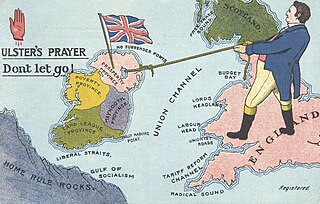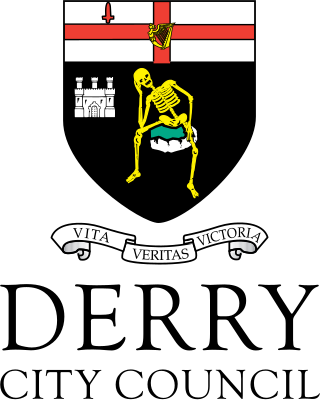Related Research Articles

The Troubles were an ethno-nationalist conflict in Northern Ireland that lasted about 30 years from the late 1960s to 1998. Also known internationally as the Northern Ireland conflict, it is sometimes described as an "irregular war" or "low-level war". The conflict began in the late 1960s and is usually deemed to have ended with the Good Friday Agreement of 1998. Although the Troubles mostly took place in Northern Ireland, at times violence spilled over into parts of the Republic of Ireland, England, and mainland Europe.

Unionism is a political tradition on the island of Ireland that favours political union with Great Britain and professes loyalty to the British Crown and constitution. As the overwhelming sentiment of Ireland's Protestant minority, following Catholic Emancipation (1829) unionism mobilised to keep Ireland part of the United Kingdom and to defeat the efforts of Irish nationalists to restore a separate Irish parliament. Since Partition (1921), as Ulster Unionism its goal has been to maintain Northern Ireland as part of the United Kingdom and to resist a transfer of sovereignty to an all-Ireland republic. Within the framework of a 1998 peace settlement, unionists in Northern Ireland have had to accommodate Irish nationalists in a devolved government, while continuing to rely on the link with Britain to secure their cultural and economic interests.

Craigavon is a town in northern County Armagh, Northern Ireland. Its construction began in 1965 and it was named after the first Prime Minister of Northern Ireland: James Craig, 1st Viscount Craigavon. It was intended to be the heart of a new linear city incorporating Lurgan and Portadown, but this plan was mostly abandoned and later described as having been flawed. Among local people today, "Craigavon" refers to the area between the two towns. It is built beside a pair of artificial lakes and is made up of a large residential area (Brownlow), a second smaller one (Mandeville), plus a central area (Highfield) that includes a substantial shopping centre, a courthouse and the district council headquarters. The area around the lakes is a public park and wildlife haven made up of woodland with walking trails. There is also a watersports centre, golf course and ski slope in the area. In most of Craigavon, motor vehicles are completely separated from pedestrians, and roundabouts are used extensively. It hosted the headquarters of the former Craigavon Borough Council.
The Sunningdale Agreement was an attempt to establish a power-sharing Northern Ireland Executive and a cross-border Council of Ireland. The agreement was signed at Northcote House in Sunningdale Park, located in Sunningdale, Berkshire, on 9 December 1973. Unionist opposition, violence and a general strike caused the collapse of the agreement in May 1974.

Coleraine is a town and civil parish near the mouth of the River Bann in County Londonderry, Northern Ireland. It is 55 miles (89 km) northwest of Belfast and 30 miles (48 km) east of Derry, both of which are linked by major roads and railway connections. It is part of Causeway Coast and Glens district.
Northern Ireland is divided into 11 districts for local government purposes. In Northern Ireland, local councils do not carry out the same range of functions as those in the rest of the United Kingdom; for example they have no responsibility for education, road-building or housing. Their functions include planning, waste and recycling services, leisure and community services, building control and local economic and cultural development. The collection of rates is handled centrally by the Land and Property Services agency of the Northern Ireland Executive.

Maghera is a small town at the foot of the Glenshane Pass in County Londonderry, Northern Ireland. Its population was 4,220 in the 2011 Census, increasing from 3,711 in the 2001 Census. It is situated within Mid-Ulster District, as well as the civil parish of Maghera, which it was named after, and the former barony of Loughinsholin.

Derry City Council was the local government authority for the city of Derry in Northern Ireland. It merged with Strabane District Council in April 2015 under local government reorganisation to become Derry and Strabane District Council.

Free Derry was a self-declared autonomous Irish nationalist area of Derry, Northern Ireland, that existed between 1969 and 1972, during the Troubles. It emerged during the Northern Ireland civil rights movement, which sought to end discrimination against the Irish Catholic/nationalist minority by the Protestant/unionist government. The civil rights movement highlighted the sectarianism and police brutality of the overwhelmingly Protestant police force, the Royal Ulster Constabulary (RUC). The area, which included the mainly-Catholic Bogside and Creggan neighbourhoods, was first secured by community activists on 5 January 1969 following an incursion into the Bogside by RUC officers. Residents built barricades and carried clubs and similar arms to prevent the RUC from entering. Its name was taken from a sign painted on a gable wall in the Bogside which read, "You are now entering Free Derry". For six days the area was a no-go area, after which the residents took down the barricades and RUC patrols resumed. Tensions remained high over the following months.

The Battle of the Bogside was a large three-day riot that took place from 12 to 14 August 1969 in Derry, Northern Ireland. Thousands of Catholic/Irish nationalist residents of the Bogside district, organised under the Derry Citizens' Defence Association, clashed with the Royal Ulster Constabulary (RUC) and loyalists. It sparked widespread violence elsewhere in Northern Ireland, led to the deployment of British troops, and is often seen as the beginning of the thirty-year conflict known as the Troubles.
The Northern Ireland Civil Rights Association (NICRA) (Irish: Cumann Cearta Sibhialta Thuaisceart Éireann) was an organisation that campaigned for civil rights in Northern Ireland during the late 1960s and early 1970s. Formed in Belfast on 9 April 1967, the civil rights campaign attempted to achieve reform by publicising, documenting, and lobbying for an end to discrimination against Catholics in areas such as elections (which were subject to gerrymandering and property requirements), discrimination in employment, in public housing and abuses of the Special Powers Act.

Rathcoole is a housing estate in Newtownabbey, County Antrim, Northern Ireland. It was built in the 1950s to house many of those displaced by the demolition of inner city housing in Belfast city. Rathcoole is within the wider Antrim and Newtownabbey Borough. Its approximate borders are provided by O'Neill Road on the north, Doagh Road on the east, Shore Road on the south and Church Road and Merville Garden Village on the west.

The Northern Ireland Public Service Alliance (NIPSA) is a trade union in Northern Ireland affiliated to the Irish Congress of Trade Unions. It is the largest trade union in Northern Ireland, with around 46,000 members, and is organised into two groups, the Civil Service Group, for the staff of public bodies employed on civil service terms and conditions, and the Public Officers Group, for employees of education and library boards, health and social services boards, the Northern Ireland Housing Executive, district councils, other public bodies and voluntary organisations.
The Derry Housing Action Committee (DHAC), was an organisation formed in 1968 in Derry, Northern Ireland to protest about housing conditions and provision.
Events during the year 1968 in Northern Ireland.
The Northern Ireland Housing Executive is the public housing authority for Northern Ireland. It is Northern Ireland's largest social housing landlord, and the enforcing authority for those parts of housing orders that involve houses with multiple occupants, houses that are unfit, and housing conditions. The NIHE employed 2,865 persons as of 31 March 2020.
Gerard Benedict "G.B." Newe, CBE, M.A., D.Litt. was a Northern Irish Roman Catholic Unionist politician and prominent Catholic layperson; he was the first Roman Catholic to be appointed a minister in the Government of Northern Ireland.
The Northern Ireland civil rights movement dates to the early 1960s, when a number of initiatives emerged in Northern Ireland which challenged the inequality and discrimination against ethnic Irish Catholics that was perpetrated by the Ulster Protestant establishment. The Campaign for Social Justice (CSJ) was founded by Conn McCluskey and his wife, Patricia. Conn was a doctor, and Patricia was a social worker who had worked in Glasgow for a period, and who had a background in housing activism. Both were involved in the Homeless Citizens League, an organisation founded after Catholic women occupied disused social housing. The HCL evolved into the CSJ, focusing on lobbying, research and publicising discrimination. The campaign for Derry University was another mid-1960s campaign.
William Lyle was a Northern Irish medical doctor and Ulster Unionist Party politician. He sat in the House of Commons of Northern Ireland for a few years in his 70s.
Boom Hall is a house and demesne in Derry, Northern Ireland. Lying close to the west bank of the River Foyle, a fort was constructed on the site during the English Civil War. During the Williamite War in Ireland a boom was constructed across the river to try to prevent Williamite forces relieving the Siege of Derry. A two-storey country house was subsequently built on the site by the Alexander family and named after this boom. The estate was later leased to a number of people until a leasehold was sold to Daniel Baird in 1849 by The 3rd Earl of Caledon. This was inherited by Daniel Baird Maturin-Baird who also purchased the freehold from the Alexanders. Boom Hall was again let to a number of different people, with Michael Henry McDevitt living there from 1924. During the Second World War, the demesne was used by the Admiralty and a number of temporary huts were built there. McDevitt purchased the freehold in 1949 and the house was renovated. It fell into disuse in the 1960s and was almost destroyed by fire in the 1970s. Part of the estate was used for the construction of the Foyle Bridge.
References
- 1 2 3 4 5 Martin Melaugh, Majority Minority Review 3: Housing and Religion in Northern Ireland, Section 2: Housing Policy and Public Reaction 1945 To 1971, CAIN, Ulster University, 1996-2018
- 1 2 3 Sir Lucius O'Brien, "The Northern Ireland Housing Trust", Journal of the Statistical and Social Inquiry Society of Ireland Vol. XXIX, Part I, 1952/1953, pp. 60-72
- ↑ Challenge - a Northern Irish Housing Trust Film, c. 1965, Northern Ireland Screen Digital Film Archive
- ↑ Orlit Homes: Oral Answers to Questions – in the Northern Ireland Assembly at 2:30 pm on 3rd February 2014, Theyworkforyou.com
- ↑ Peter Guillery, Built from Below: British Architecture and the Vernacular, Routledge, 2010, p. 182
- ↑ Marie Louise McConville, "Housing plan which proposed sprawling Divis project was 'disaster waiting to happen'", The Irish News, 8 December 2018
- ↑ Imogen McGuckin, Marianne Elliott on the Challenges Faced by the Northern Ireland Housing Trust in Belfast City, University Times, 9 March 2017
- 1 2 First Annual Report, Northern Ireland Housing Executive, 13th May 1971 to 31st March 1972
- ↑ Text of the Housing Executive Act (Northern Ireland) 1971, CAIN, Ulster University
- ↑ J. B. Cullingworth and Vincent Nadin (2001). Town and Country Planning in the Uk. Routledge. p. 52. ISBN 0-415-21775-X.
- ↑ Gerald McSheffrey (2000). Planning Derry: Planning and Politics in Northern Ireland. Liverpool University Press. p. 101. ISBN 0-85323-724-7.